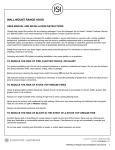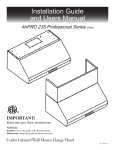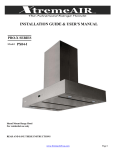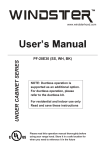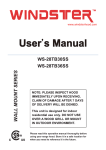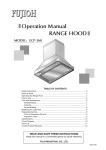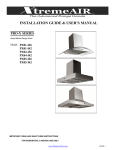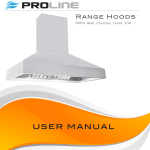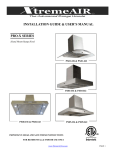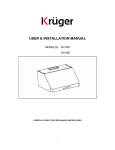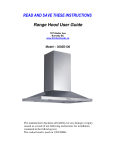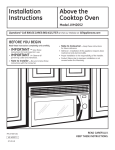Download ISLAND RANGE HOOD - Signature Hardware
Transcript
ISLAND RANGE HOOD USER MANUAL AND INSTALLATION INSTRUCTIONS Unpack and inspect the product for any shipping damages. If you find damages, do not install. Contact Customer Service at 1-866-855-2284. If you need assistance or have questions contact Customer Service. The installation in this manual is intended for qualified installers, service technicians or persons with a similar qualified background. Installation and electrical wiring must be done by qualified professionals and in accordance with all applicable codes and standards, including fire-rated construction. Do not attempt to install this appliance yourself. Injury could result from installing the unit due to lack of appropriate electrical and technical background. Range hood may have very sharp edges; please wear protective gloves if it is necessary to remove any parts for installing, cleaning or servicing. Activating any switch ON before completing installation may cause ignition or an explosion. TO REDUCE THE RISK OF FIRE, ELECTRIC SHOCK, OR INJURY For general ventilating only. Do not use to exhaust hazardous or explosive materials and vapors. Do not vent the exhaust into spaces between walls, crawl spaces, ceiling, attics or garages. Before servicing or cleaning the range hood, switch the power Off and lock the service panel. Old ductwork should be cleaned or replaced as necessary to avoid the possibility of grease fires. Check and tape all duct joints to ensure proper connections. TO REDUCE THE RISK OF A STOVE TOP GREASE FIRE Clean all grease laden surfaces frequently. Grease should not be allowed to accumulate on the fan, baffle, spaces, filter, grease tunnel or oil container. Always turn range hood On when cooking at high heat or when cooking flaming foods. Never leave the surface units unattended at high settings. Boil-overs may cause smoking and spillovers that may ignite. Heat any oils slowly on Low or Medium settings. Always use appropriate cookware and utensils. TO REDUCE THE RISK OF INJURY IN THE EVENT OF A STOVE TOP GREASE FIRE Smother flames with a close-fitting lid, cookie sheet or metal tray and turn off the burner. Never pick up a flaming pan. Keep any flammable or combustible material away from flames. If the flames do not go out immediately, evacuate and call the fire department. Do not use water, including wet dishcloths or towels, a violent steam explosion will result. Island Range Hood Installation Instructions 1 Use an extinguisher only if: you know you have a Class A, B, C extinguisher, you know how to operate the extinguisher, the fire is small and contained in the area where it started, the fire department is being called and you can fight the fire with your back to an exit. TO REDUCE THE RISK OF INJURY TO IN THE EVENT OF A GAS LEAK Extinguish any open flames. Do not turn on the range hood fan, any type of ventilator or any appliances. Open all doors and windows to disperse the gas. If the gas odor is still present, contact the gas company and fire department immediately. Signature Hardware declines all responsibility in the event of failure to observe the instructions given here for installation, maintenance and suitable use of the product. Signature Hardware further declines all responsibility for injury due to negligence and the warranty of the unit automatically expires due to improper maintenance. Signature Hardware will not be held responsible for any damages to personal property or real estate or any bodily injuries whether caused directly or indirectly by the range hood. VENTING REQUIREMENTS The vent system must terminate to the outside via the roof or side wall. Never terminate the vent system to an attic or other enclosed area. Do not use 4" laundry-type wall caps. Use aluminum venting only. Always keep the duct clean to ensure proper airflow. Before installation, collect the following measurements: 1. 2. 3. 4. Ceiling height Distance from floor to stove or counter top Distance from stove or counter top to range hood Height of hood and duct cover. FOR THE MOST EFFICIENT AND QUIET OPERATION A distance of 28"-31" is recommended between the stove top and the bottom of the range hood. It is recommended that the range hood be vented vertically through the roof through 6" or larger round aluminum venting. Use no more than three 90° elbows. Make sure there is a minimum of 24" of straight vent between the elbows if more than one is used. Never install two elbows together. Island Range Hood Installation Instructions 2 The vent system length should be kept to a minimum to provide efficient performance. Use duct tape to seal all joints in the vent system and caulking to seal the exterior wall or roof opening around the cap. DUCTLESS CONVERSION Ductless conversion is intended for applications where exhaust duct work cannot be installed. When converted, the hood functions as a purifying hood rather than an exhaust hood. Fumes and exhaust from cooking are drawn and filtered by a set of charcoal filters. The air is then purified and re-circulated back within the home. We recommend to always exhaust air outside of the home by employing existing or installing new duct work if possible. Only convert the hood into a purifying unit when the exhaust option is not available. When converted to be a “purifying” unit, a set of charcoal filters and an air diverter are required in addition to the standard aluminum filter set, all available at your local hardware store. The standard aluminum filters are intended to capture residue from cooking, the optional charcoal filters help to purify fumes exhausted from cooking, and the optional air diverter redirects filtered clean air back to the house. CHARCOAL FILTER INSTALLATION If you purchased the range hood with re-circulating kit from Signature Hardware, the charcoal filters are preinstalled. 1. 2. 3. Remove aluminum filters on hood. Position the charcoal filters onto each side of the motor and turn until it locks. Re-install aluminum filters. Charcoal filters must be replaced after 120 hours of use (or approximately every 2 to 3 months based on the average of 1 to 2 hours of daily cooking time). Available at your local resellers. ELECTRICAL REQUIREMENTS Observe all governing codes and ordinances. (Please consult with a qualified electrician for 220-Volt 50 Hz voltage) It is the customer’s responsibility: 1. To contact a qualified electrical installer. 2. To ensure that the electrical installation is adequate and in conformance with National Electrical Code. If a separate ground wire is used (code permitting), it is recommended that a qualified electrician determine that the ground path is adequate. A 120-Volt, 60 Hz, AC-only (USA & Canada standard), fused electrical supply is required on a separate 15-amp circuit, fused on both sides of the line. Do not ground to a gas pipe. Check with a qualified electrician if you are not sure that the range hood is properly grounded. Do not have a fuse in the neutral or ground circuit. Island Range Hood Installation Instructions 3 Important: Save this Installation Guide for electrical inspector’s use. The range hood must be connected with copper wire/plug only. The range hood should be connected directly to the fused disconnect (or circuit breaker) box through flexible armored or non-metallic sheathed copper cable. A U.L. or C.S.A. listed strain relief must be provided at each end of the power supply cable. Wire sizes (copper wire only) and connections must conform with the rating of the appliance as specified on the model/serial rating label. Wire sizes must conform to the requirements of the National Electrical Code. BEFORE INSTALLATION Advanced Preparations: Be familiar with the controls of the range hood by reading through the “Range Hood Operations” section. Place the range hood on a flat, stable surface. Connect the range hood to a designated standard outlet (please refer to the product label for the suitable voltage of this unit) and turn on the range hood. Verify all operations of the range hood by referring to “Range Hood Operations”. Place all supplied parts and required hardware on a flat, stable surface. Carefully remove the plastic protective coat from the chimney covers and range hood. To avoid damage to your hood, prevent debris from entering the vent opening. Preparations: 1. Determine and mark the center line on the ceiling where the range hood will be installed. Make sure there is proper clearance within the ceiling or wall for exhaust vent. 2. Due to the weight and size of this unit, please make sure that the support system or framework being used is stable and secure in the wall. 3. Put a thick, protective covering over the counter-top, cook top or range to protect from damage or dirt. Remove any hazardous objects around the area when installing. 4. Mark the locations of the support mounting bracket holes, vent cutout (if used) and power supply cable cutout on the ceiling. Use drill and saber saw or keyhole saw to cut openings for power supply cable and vent. 5. If venting to the outside, install vent system. Use caulking to seal exterior wall or roof openings. 6. Disconnect the main electrical supply, prepare and run electrical wiring through ceiling or wall. Leave approximately 12" of electrical cord hanging from the ceiling. Do not restore power until wiring is complete. 7. Disconnect the power cord, remove the aluminum filter by pressing on the latch toward the direction of solid arrow while holding the metal handle, gently pull the aluminum filter toward the direction of dashed arrow. Island Range Hood Installation Instructions 4 8. Remove the charcoal filter if present. 9. Set aside the aluminum and charcoal filters until the range hood is properly installed. 10. If the range hood comes with a glass canopy and has not already been mounted to the hood, place the canopy on the hood top, and tighten the canopy screws and washers. Do not put excessive pressure against the glass. INSTALLATION Pencil or Chalk Level Adjustable Wrench 1. 2. 3. 4. Utility Knife Drill Tape Measure Screwdriver Drill mounting holes into the false ceiling. Install two hexagonal wood screws. Cut out a 7-1/2" diameter circle for duct work. Place support frames inside the top support plate, adjust support frames to the appropriate length and lock the support frames with tapping screw. Align the holes in the top support plate with the mourning holes in the ceiling. Push the plate up and slide forward to lock into place. Insert wood screws into the remaining mounting holes. Caution: Make sure the support frame fixture is secure before releasing. 5. Slide in the upper and lower chimneys, minimize chimney movements to avoid scratches. 6. If installing a recirculating kit, place the air diverter directly above the range hood with the 6" round hole facing. downward. Mark the locations of the air diverter holes on the wall. If not installing a recirculating kit move on to the next step. 7. Install the duct set onto the body of the hood with tapping screws. Install aluminum duct tube on the duct set and make sure all joints are secured and air tight. Note: Due to excessive weight, two or more people are recommended for this step. 8. Install the hood body onto the support frame and secure with tapping screws. Make sure the hood is secure before releasing. Run the duct tube and power cord through the top support plate above the ceiling. 9. Install the duct tube onto the air diverter (if installed) and use duct tape to ensure a secure and air tight connection. 10. Hold the upper and lower chimneys in position and slowly slide them down until sitting on the hood. Connect the duct work and power cable. Bring the upper chimney up until it reaches the ceiling and secure. Island Range Hood Installation Instructions 5 RANGE HOOD OPERATIONS Power Function Decrease Increase LED Panel Fan Activation: • • With the range hood power Off, press the Power button to start the fan. While the range hood power is On, press and hold the Function button to enter the fan function setting mode. Press the Increase button to increase the fan speed (F0-F6) as indicated on the LED Panel. With the range hood power On and the fan running, press the Decrease button to decrease the fan speed (F6-F0) as indicated on the LED Panel. • • • • • • • • Lighting Activation: Press the Function button one time to turn the lights On, and one time to the lights Off. Press the Increase button to brighten the lights (F0 to F3) as indicated on the LED Panel. Press the Decrease button to dim the lights (F3 to F0) as indicated on the LED Panel. Caution: do not touch the lights until turned off and cooled. Power-Off Delay Activation: While the range hood is on and the fan is running in normal mode, press the Function button to activate the delay off timer. The Power-Off Delay icon will appear on the LED Panel. Adjust to the desired period by pressing the Increase or Decrease button (minimum 1 minute to maximum 15 minutes). The timer will begin immediately, when the timer reaches 0, the fan will shut off. Heat Sensitive Auto Speed (HSAS) Adjustment: Press and hole the Function button to enter the temperature setting mode. C° or F° will appear on the LED Panel. Press the Increase or Decrease button to select the desired temperature mode. Press the Increase or Decrease button to adjust to the desired temperature. The heat sensor evaluates the surrounding temperature continuously and increases the fan to the highest speed automatically when the set temperature is reached. When the surrounding temperature drops below the set temperature, the fan returns to the original speed by decreasing one speed level every 3.6° drop. Island Range Hood Installation Instructions 6 TROUBLESHOOTING • Range hood or halogen light does not operate properly: • Make sure that the duct sized used is at least 6" or 3 -1/4x10”. The range hood will not function efficiently with insufficient duct size. For example: 7” duct over 6” hole and loosely secured. Check if duct is clogged or if damper unit (half-circular flapper) is not installed correctly or opening properly. A tight mesh on a side wall cap unit might also cause restriction to the air flow. Verify that the range hood has been plugged in, make sure that all power has been turned back On, the fuse has not blown and that all electrical wiring is properly connected. • Swap out the light assembly with working a assembly to determine if it is caused by defective bulbs. Range hood vibrates when fan is operating: The range hood might not have been secured properly to the ceiling or wall. Check with your installer. Fan seems weak: • • The lights work but the blower is not spinning, it is stuck or it is rattling: • The blower might be jammed or scraping the bottom due to shipping damages. Please contact Customer Service immediately. The hood is not venting out properly: • • Make sure the distance between the stove top and the bottom of the hood is within 28"-31". Reduce the number of elbows and length of duct work. Verify that all joints are properly connected, sealed, and taped. Make sure the power is on high speed for heavy cooking. • Island Range Hood Installation Instructions 7 MAINTENANCE Safety Warning: Never put your hand into the fan area while the fan is operating. For optimal operation, clean the range hood and all parts regularly. Regular care will help preserve the appearance of the range hood. Cleaning Exterior surfaces: • • • • Clean periodically with hot soapy water and a clean cotton cloth. Do not use corrosive or abrasive detergents, or steel wool/scoring pads, which will scratch and damage the stainless steel surface. If your stainless steel hood looks splotchy, use a stainless steel cleaner to clean the surface of the hood. Avoid getting cleaning solution on or in the control panel. Do not leave the cleaner on the hood for an extended period of time as this may cause damage to hood finish. Use soft towel to wipe off the cleaning solution and gently rub off any stubborn spots. Use a dry soft towel to dry the hood. After cleaning, you may use non-abrasive stainless steel polish to polish and buff out the stainless luster and grain. Always scrub lightly with clean cotton cloth and with the grain. Do not use ordinary steel wool or steel brushes. Small bits of steel may adhere to the surface and cause rusting. Do not allow salt solutions, disinfectants, bleaches, or cleaning compounds to remain in contact with stainless steel for extended periods. Many of these compounds contain chemicals, which may be harmful. Rinse with water after exposure and wipe dry with a clean cloth. Cleaning Grease Filter or Grill: • • • • Drain oil from oil containers before oil and residue overflow. The metal filters fitted by the factory are intended to filter out residue and grease from cooking. Filters may not need to be replaced on a regular basis but are required to be kept clean. Filters should be cleaned after every 30 hours of use. Remove and clean by hand or dishwasher. Apply detergent and let soak if heavily soiled. Dry filters and re-install before using hood. Replacing Filters: • Should filters wear out due to age and prolonged use, please contact your local reseller for replacement filters. Also replace damaged filters if there is punctured or broken mesh, or a bent or broken frame. Replacing the light bulb: • • • • This range hood uses halogen bulbs (please refer to the actual specification of the hood purchased). Make sure the range hood is unplugged or turn off the circuit breaker. Make sure the lights are cool to touch, carefully align the arrow on the inner ring with the arrow on the outer ring and the word OPEN. The inner ring will loosen and the light bulb will be available for removal. Install the new halogen light bulb. Turn the circuit breaker and range hood on to test for operation. Island Range Hood Installation Instructions 8








